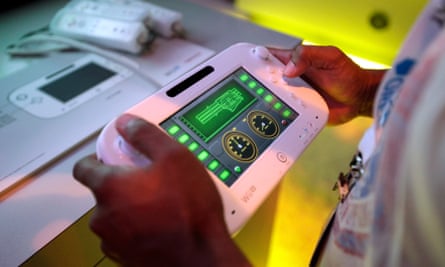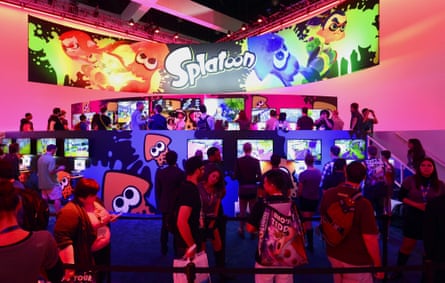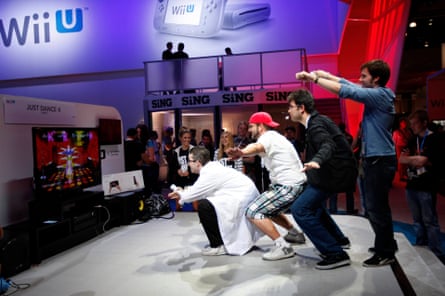As I sprint down London’s Oxford Street, past a queue snaking down the puddle-soaked road, I spot a familiar face smiling back at me. “Sorry I’m late,” I splutter, muttering something about the trains. The year is 2012, and on this particularly grim November evening, my (then) girlfriend and I are huddled in the cold for the Wii U’s midnight launch. This, I thought, is the games console that will change everything.
Looking back 10 years later, I’m not sure what is more surprising: that my girlfriend of three months was willing to queue in the cold for five hours outside a HMV, or that I genuinely believed the Wii U would be a hit. Needless to say, it really was not. Shifting just 13.65m units in its lifetime – compare that to the original Wii’s 100m – the Wii U was a failure of gargantuan proportions that tanked Nintendo’s share price.
But to 21-year-old Tom in 2012, the Wii U was tantalising. Nintendo had dominated living rooms for years thanks to the success of the waggle-tastic Wii, but that came at the expense of its hardcore fans, who found themselves drawn towards the Xbox 360 or PlayStation 3 instead. The Wii U was an attempt to win back gamers, alongside the broader audience that the Wii had so successfully courted. To paraphrase then-Nintendo of America president Reggie Fils-Aimé at the console’s reveal, the Wii was a box for everyone – the Wii U was a box for everyone … and for you. Clear as muddy water.
Thanks to its Fisher Price-looking plasticky controller, underpowered specs and abysmal marketing (even the name was needlessly confusing), the Wii U was perhaps doomed from day one. Yet it’s probably the most endearingly weird console I’ve owned. From Nintendo’s bizarre attempt at a social network, Miiverse – shout out to the user obsessed with in-game water – to some of history’s best, most unusual multiplayer games, the Wii U is home to many of my fondest gaming memories.
Where Sony and Microsoft abandoned split-screen for online multiplayer, Nintendo’s misunderstood console quietly united mates and families, becoming the de facto HD party console. Nintendo Land, the tragically ignored set of mini-games that came with the console, was Wii U’s secret weapon. Living with my parents and attempting to figure out my life while working bar jobs, Nintendo Land became the star of many rowdy pre-drinks, thanks to the brilliant double act of Mario Chase and Luigi’s Ghost Mansion.
Where a lot of Wii U games lazily whacked a menu on the gamepad’s small screen, or some pointless touch controls, Nintendo Land fully sold the two-screen dream. Here, the player with the gamepad competed against everyone else. In Mario Chase – Nintendo’s version of hide and seek – the gamepad-clutching runner would sprint towards a hiding place and wait for the pursuit to begin, while team TV would become the Mario-chasing mob, shouting garbled orders to locate their moustachioed prey and cut off his escape. Honestly, it’s an absolute riot. Nintendo Land hinted at a world of promise for Nintendo’s two-screen wonder, but sadly it was never fulfilled.
Things looked hopeful at first. Another early adventure that made the gamepad sing was undead horror game ZombiU, which forced players to rifle around in their backpacks in real time on the gamepad – while hordes of the undead closed in on the TV. It’s one of the few games that really does London justice, too, letting you cave zombie skulls in with a cricket bat.

It felt like Nintendo was in a period of seemingly random risk-taking during this period, which is what made the Wii U and its games so endearing. Case in point: Super Mario 3D World, which transformed the single-player institution of 3D Mario into a co-op-epic, combining the most joyous elements of 2D Mario with four-player catsuit-wearing shenanigans. Speaking of platforming classics, Rayman Legends was also an utter delight. My mates and I became weirdly obsessed with its half-baked football competitive mini game, Kung Foot – shout-out to the 10 other people that played it.
Whenever we would tire of Nintendo Land, we’d turn to the Wii U’s crown jewel, Mario Kart 8. Given that it’s still selling millions on the Nintendo Switch, it’s easy to forget that the best Mario Kart took its first corner on Wii U. Actually, most of the Wii U’s underloved classics got another shot at fame on the Nintendo Switch, years later. Squid-kid paintball game Splatoon was the big N’s first attempt at an online shooter, and while it didn’t come close to rivalling Halo or Overwatch, it offered a charming take on an often uninspired genre.
When my ex and I eventually moved in together, we probably became one of the only households on the planet to have two Wii Us. While she threw ink around in Splatoon, I became utterly enraptured by 2014’s Bayonetta 2. Even today, it’s an action extravaganza that can’t be topped.

The Wii U was also the original home of one of gaming’s all time greats – The Legend of Zelda: Breath of the Wild. Hell, for Zelda diehards, the Wii U is still the best console around – the only place you can enjoy Wind Waker and Twilight Princess in high definition. While I don’t have the column space to gush over all of the Wii U’s bangers, honourable mentions go to Pikmin 3, cult classic RPG Xenoblade Chronicles X, and oddities such as Runner 2, Tokyo Mirage Sessions, Affordable Space Adventures and Captain Toad: Treasure Tracker.
Nintendo’s first attempt at a HD console may have been a flop of Magikarp-worthy proportions, but it’s rightly amassed a cult following. As the big N caught up with HD development in real time, this box saw Nintendo at its madcap best – and it’ll always feel weirdly formative for me. Somewhat weirdly, my aforementioned relationship followed the same trajectory as the Wii U, fizzling out just as the Nintendo Switch found its swagger.
Whether you loved it or hated it, without the Wii U, we wouldn’t have the hybrid handheld/console brilliance of the Switch. From core concept to games, the Wii U limped so the Switch could run. Happy 10th birthday mate – you can better believe I’ll be revisiting some Wii U classics in your honour.

